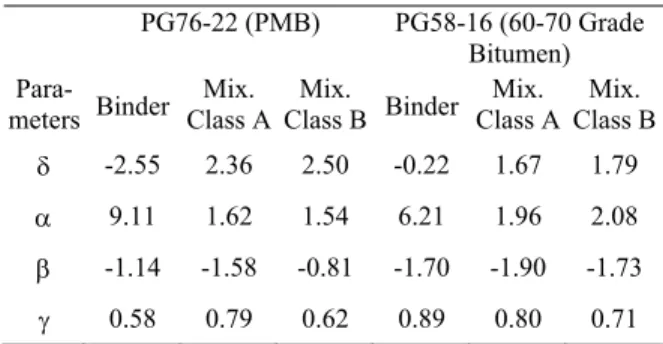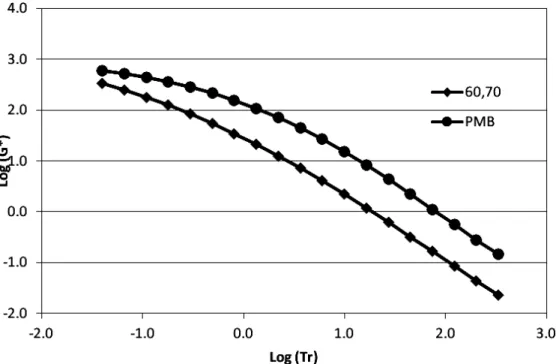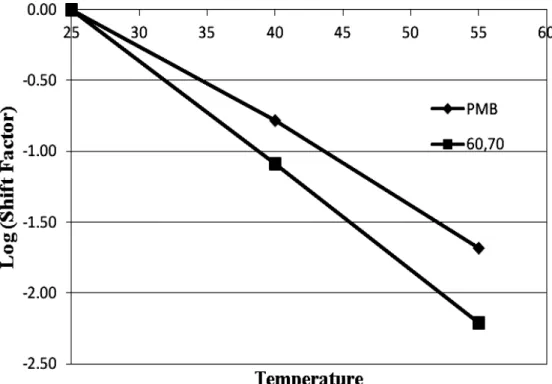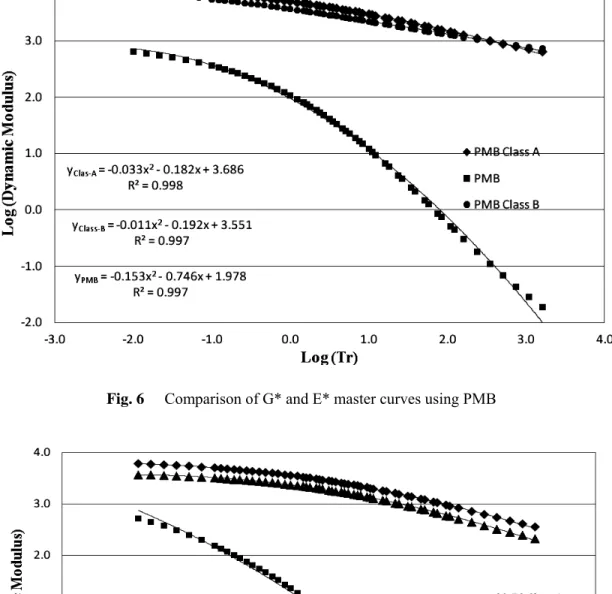Performance Prediction of Hot Mix Asphalt from Asphalt Binders
Imran Hafeez*, Mumtaz Ahmed Kamal, Muhammad Reza Ahadi, Qamar Shahzad, Nadia Bashir,1. Assistant Professor, Department of Civil Engineering, University of Engineering & Technology, Taxila, Pakistan E-mail: imranhafeez783@yahoo.com
2. Professor, Department of Civil Engineering, University of Engineering & Technology, Taxila, Pakistan E-mail: drmakamal@yahoo.com
3. Assistant Professor, Transportation Research Institute (TRI), Ministry of Road & Urban Development. Tehran, Iran E-mail: ahadi@rahiran.r
4. Research Scholar, M.Sc, Department of Civil Engineering, University of Engineering & Technology, Taxila, Pakistan E-mail: shah_civil1@yahoo.com
5. Research Scholar, M.Sc, Department of Civil Engineering, University of Engineering & Technology, Taxila, Pakistan E-mail: diya_engr@yahoo.com
Abstract
Asphalt binder being a high weight hydrocarbon contains asphaltene and maltene and is widely used as cementing materials in the construction of flexible pavements. Its performance in hot mix asphalt also depends on combining with different proportions of aggregates. The main objective of this study was to characterize asphalt cement rheological behavior and to investigate the influence of asphalt on asphalt-aggregate mixtures prepared with virgin binders and using polymers. Binder rheology and mixtures stiffness were determined under a range of cyclic loadings and temperature conditions. Master curves were developed for the evaluation of relationship between parameters like complex modulus and phase angle at different frequencies. Horizontal shift factors were also computed to determine time and temperature response of binders and mixes. The results showed that the stiffness of both the binder and the mixes depends on temperature and frequency of load. Polymer modified binder is least susceptible to temperature variations as compared to other virgin asphalt cement. Performance of asphalt mixtures can be predicted from those of asphalt binders using the master curve technique.
Key Words
: Rheological Parameter; Dynamic Modulus; Phase Angle; Master Curves; Shift Factors.1. Introduction
Bitumen commonly known as asphalt cement (AC) is used as binding materials in road pavements and contain approximately 82-88 % carbon, 8-11 % hydrogen, 0-6 % sulphur, 0-1.5 % oxygen and 0-1 % nitrogen [1-2]. Asphaltene and maltene are the constituents of asphalt cement which directly control its chemical composition and physical properties. Asphaltene as highly polar, complex aromatic materials, having high molecular weight normally ranges between 5% and 25% and has significant effect on the overall properties of bitumen. Higher asphaltene content bitumen has more viscosity, lower permeability and high softening point resulting harder bitumen. Polar nature of aromatic control
viscosity, while polar nature of the resins gives the bitumen its adhesive properties and they act as dispersing agents for the asphaltene. Resins provide adhesive properties and ductility to the bituminous materials [3]. Saturates, aromatics and resins are the three basic components of maltene. Saturates are waxy or non-waxy in nature and form 5% to 20% of the bitumen. These mainly consist of straight and branched-chain aliphatic hydrocarbons together with alkyl naphthalene and some alkyl-aromatics [4].
Rheology is the study of deformation and flow of bitumen that explains the elastic and viscous behavior of bitumen, when subjected to a stress [5-6]. Complex modulus (G*) and phase angle (δ) are considered to be the principal rheological parameters,
normally measured from a device known as Dynamic Shear Rheometer (DSR) [7]. A number of studies had been conducted to investigate asphalt binder rheology [8-11].
Asphalt concrete is a mixture of bitumen and aggregates (inorganic heavy fillers, sands, grit, stones) of various kinds used for construction of road surfaces. Its behaviour is linear visco-elastic under the application of load, this element of the total strain is irrecoverable and with the repeated load application it accumulates, leading to the formation of surface ruts [12]. Performance of asphalt mixtures in terms of linear visco-elastic behavior can be predicted using stress-strain behavior which can be defined by a dynamic or complex shear modulus [13-14]. Dynamic modulus (E*) the ratio of absolute value of the peak to peak shear stress by the absolute value of the peak to peak shear strain under sinusoidal loading conditions [15-16].
The viscoelastic properties can be evaluated by constructing a Master Curve (MC) of the stiffness modulus and the phase angle obtained from the test data over a range of temperatures and frequencies, providing a fundamental characterization of asphalt concrete in which the time and temperature dependencies are fully described [17]. The MC enables the prediction of the moduli at any loading frequency or temperature and assists in the comparison of data on an equal basis. Various functional forms can be used to mathematically model the response of asphalt mixes. For low and intermediate temperatures, the generalized power law is suitable for shifting asphalt mix test data [18]. For a full temperature range, a sigmoidal fitting function is considered to be more appropriate based on the observed mix behavior [19].
Colbert and Zhanping (2012) characterized the rheological properties of asphalt binders extracted from a recycled asphalt pavement (RAP) mixture and observed significant differences in dynamic shear moduli master curve performance for high percentage RAP binder blends versus virgin binders at the three aging states [20]. Nur et al (2011) based on existing literature reported that the use of reliable models can in general, be considered as a valuable alternative tool for estimating the Linear viscoelastic rheological properties of bitumen [21]. Wasage et al (2011) recommended the significance of creep compliance
on G*/sinδ in predicting the rutting behavior of asphalt mixtures [22]. Kumar et al (2011) studied the effect of styrene butadiene styrene (SBS) polymer and crumb rubber modified asphalt binders on asphalt mixtures dynamic mechanical behavior. Simple performance tests like dynamic modulus, dynamic and static creep tests were carried out at varying temperatures and frequency levels. It was revealed that the mechanical response of SBS polymer modified asphalt binders were significantly correlated with the rutting resistance of asphalt concrete mixes [23].
Relationship between the dynamic modulus in compression |E*| of the asphalt mixer to the G*, complex shear modulus of the binder developed through engineering mechanics has been generated by equation 1 [24];
∗ + =
∗ G
E 2(1 µ) (1)
In the current study relationships between two master curves constructed for asphalt mixtures and asphalt binders were plotted on the same space to compare and predict E* from G*.
2. Research
Objectives
Following are the main objectives of the study;
i. To Characterize asphalt binders using elastic modulus and phase angles.
ii. To develop the master curves and hence the horizontal shift factors;
iii. To find out the possible correlation between asphalt binders and asphalt mixtures using the master curve techniques.
3. Test
Materials
Experimental design of this research paper is presented in Table 1.
3.1 Binders
PG76-22 and PG58-16 were selected from Attock Refinery Limited, Rawalpindi, Pakistan. These binders have extensively being used on major highways and motorways which are carrying approximately 75% of the total road freight in Pakistan. Specimens were aged using Rolling Thin Film Aging Oven Test (RTFOT) according to the
AASHTO T 240 protocol on each binder [25]. Sinusoidal, oscillatory stress over a range of temperature and loading frequencies were applied to a 25mm diameter and 3mm thin disc of asphalt binder using Dynamic Shear Rheometer [26]. Dynamic Shear Rheometer was used to determine the phase angle and the elastic and viscous components known as storage modulus and loss modulus, respectively. Complex Shear Modulus of two binders at temperatures of 25, 40 and 55oC and frequency range of 100 Hz to 0.1Hz were determined.
3.2 Asphalt Mixes
Four asphalt mixtures were prepared using two binders and two aggregate gradations namely Class-A (Coarser) and Class-B (Finer) using NHClass-A specifications [27]. Mixtures were tested on repeated load uniaxial loading testing machine under sinusoidal loading pulse [28]. Asphaltic specimens of 180mm height and 150 mm diameter were prepared on superpave gyratory compactor at average air voids of 7±0.2%. These specimens were then cored to 150mm height by 100mm diameter with average air voids of 3.5%.
A sinusoidal compressive stress wave was applied to test specimens at loading frequencies of 25, 10, 5, 1, 0.5, and 0.1 Hz in a temperature control chamber (Figure 1). These frequencies were built in by default in the software set up. Main purpose to choose controlled stress was to get lower numbers of cycles to failure at known stress as compared to controlled strain test.
Fig. 1 Sinusoidal loading pulse pattern in dynamic modulus testing [28]
Three stress levels at uniform interval within the ranges specified in AASHTO TP-62, at each temperature were selected and reported in Table 2. Table 1: Experimental Design
Step No. Descriptions Details of activities in the experimental design
1 Materials
Asphalt Binders
• PG76-22
• PG 58-16
Asphalt Mixtures
• PG76-22 +Class-A
• PG76-22 +Class-B
• PG58-16 +Class-A
• PG58-16 +Class-B 2 Testing machine/
Procedures
Frequency sweep test at Dynamic Shear Rheometer
Dynamic modulus testing at NU-14 as per AASHTO TP 62
3 Testing Conditions Frequency:100 to 1Hz Temperature ; 25, 40, 55oC
Frequency: 25 to 0.1Hz Temperature ; 25, 40, 55oC 4 Output parameters Complex shear modulus (G*)
Phase angle (δ)
Dynamic modulus (E*) Phase angle (φ) 5 Characterization
Master curves development Shift factor computation, Sigmoidal parameters of best fit
Master curves development Shift factor computation, Sigmoidal parameters of best fit 6 Generating the Correlations Comparison of G* and E* master curves on single plots and development of relationships at highest degree of determinacy
Table 2 Stress levels to each temperature Temperatures (oC)
Description 25 40 55
Stress Level (kPa) 700, 500 300 250, 200 150 70, 50 30 Two parameters dynamic modulus E* and phase angle φ were obtained from these tests. The rutting factor, a parameter to measure rutting characteristics of E*/sinφ for mixes, at a particular frequency and temperature was also computed.
4. Results and Discussions
4.1 Test results
Two binders and four mixes were studied under different time and temperature conditions and master curves were developed for the evaluation of relationship between complex modulus and phase angle at different frequency levels. Shift factor curves were also plotted to determine temperature sensitivity of binders and mixes.
Results showed that temperature and frequency of loading has significantly influenced the behavior
of asphalt. The complex modulus decreases with an increase in test temperature under a specific loading frequency, whereas it increases with an increase in frequency at a specified temperature. This shows that the elastic portion of viscoelastic property reduces over a range of temperature from 25oC to 55oC. The complex shear modulus and phase angle values of binders have been reported in Table 3. The phase angle values of the binders mostly ranged between 70o and 87o, whereas for mixes it ranged from 12oto 33o. These values of phase angles for both asphalt binders and mixtures confirm the results of previous research and in accordance with their limits. Also, phase angle of above asphalt mixtures are three times less than the corresponding asphalt binders at any temperature and frequency level. The reduction is mainly contributed by the aggregates in the mixtures.
The elastic modulus (G*) of binder mostly range between 20 kPa and 1 kPa and that of mixtures between 400 and 4000kPa. A significant change was observed for the within the selected temperature range which depicts the changed behavior of asphalt mixes over the said range of temperatures in the field. Table 3a Complex shear modulus (G*) of asphalt binders
PG76-22 (PMB)
PG58-16
(60-70 Grade Bitumen) Temperature Description
G* at 0.1Hz
(kPa) Phase Angle (δ)
G* at 0.1Hz
(kPa) Phase Angle (δ)
25 oC 20.72 72.44 12.479 77.56
40 oC 5.65 81.80 3.97 82.18
55 oC Asp
h
alt Bind ers
1.40 87.41 1.00 87.33 Table 3b Dynamic modulus (E*) of asphalt mixtures
PG76-22 (PMB)
PG58-16
(60-70 Grade Bitumen) Temperature Description of Mixtures
E* at 0.1Hz (kPa)
Phase Angle (φ)
E* at 0.1Hz (kPa)
Phase Angle (φ)
Class-A 3897 17.46 2811 19.46 25oC
Class-B 2978 21.09 1754 22.34 Class-A 1652 23.27 956 25.56 40oC
Class-B 1245 27.96 743 30.02 Class-A 1157 28.59 453 31.84 55oC
4.2 Development of Master Curve
Change of viscoelastic properties of asphalt binders were studied by applying the Time and Temperature super positioning (TTS) method, which describe the same viscoelastic values measured from different temperature over the same time. The viscoelastic properties measured at 40 and 55oC were shifted to 25oC by a horizontal shift (aT). The data of elastic modulus was plotted against time and shifted with respect to log of time to a single reference temperature of 25oC to get a smooth master curve as shown in Figure 2 and 3. These curves actually describe the time and temperature dependent shear properties of asphalt binders.
Similar plots were observed for both modified and unmodified asphalt binder over the entire test frequency range, but higher G* values of PMB than 60-70 grade bitumen. This shift is due to the presence of elvaloy polymers in the base 60-70 grade bitumen. Master curves of asphalt mixtures were also plotted on same space as shown in Figure 3, to investigate the effect of binder and aggregate gradation type on their viscoelastic behavior.
One can observe clear distinctive effects of both the binders and gradations. These Figures show that PMB is least effective of temperature and time of loading as compared to 60-70 grade bitumen. Asphalt mixtures with PMB and coarser aggregate gradation showed higher E* values at all frequency levels. Also, asphalt mixture with coarser aggregate gradation and 60-70 grade bitumen and finer aggregate gradation with PMB showed almost similar stiffness. This means that the effect of binder stiffness can be equalized with improved aggregate gradation on the coarser side.
4.3 Shift Factory
The amount of horizontal shift required for each temperature in construction of MC has been shown in Figure 4 and 5.
Figure 4-5 show the influence of temperature on the amount of horizontal shift factors for each asphalt binder and their mixtures. One can conclude the fact that addition of polymers in the straight run bitumen decreases the temperature sensitivity of both the binder and prepared mixtures. As the penetration
grade of bitumen increases and aggregate gradation becomes finer the slope of shift factor line also increases, which can be referred to their temperature sensitivity.
4.4 Sigmoidal parameters of Master Curves
Sigmoidal parameters best describes the shape and the location of the master curve by mathematically modelling, using equation 2 [29].
) (log
1
*
Tre
E
Log
δ
βα
+γ+
+
=
(2) Where δ, α are known to be the fitting parameters that depend on aggregate gradation, binder contents and air void, while β, γ depend on characteristics of asphalt binder and describes the shape of the sigmoidal functions. Above coefficients of Sigmoidal functions (δ, α, β, & γ) for binders and mixtures were determined simultaneously and reported in Table 4 for comparison purposes.
Table 4 Sigmoidal parameters for binders and mixtures.
PG76-22 (PMB) PG58-16 (60-70 Grade Bitumen)
Para-meters Binder Class AMix. Class B Binder Mix. Class AMix. Class BMix.
δ -2.55 2.36 2.50 -0.22 1.67 1.79
α 9.11 1.62 1.54 6.21 1.96 2.08
β -1.14 -1.58 -0.81 -1.70 -1.90 -1.73
γ 0.58 0.79 0.62 0.89 0.80 0.71
4.5 Comparison of Master curves
Master curves of asphalt binders (log G*) and mixtures (log E*) are plotted on single space as presented in Figure 6 and 7. Figure 6 contains master curve of PMB and mixtures prepared with the same binder, while Figure 7 contains master curve of 60-70 grade bitumen and mixtures prepared with the same binder. One can observed similar trends of asphalt binders and mixtures. At low frequency the asphalt binder response becomes viscous and the slopes of curve become steeper. One can conclude from these Figures that using the PMB in asphalt mixtures the effect of aggregate gradation is not significant as
Fig. 2 Development of master curves for asphalt binders
Fig. 4 Horizontal shift factor trends for asphalt binders
Fig. 6 Comparison of G* and E* master curves using PMB
compared to 60/70 grade bitumen. This can be mathematically proved from the coefficients of curve fitting line equations. A higher degree of determinacy (R2) of around 0.99 indicates that sigmoidal functions have provided best fitness of the curve over the entire data range.
5. Conclusions
This study characterizes two binder types and four asphalt mixes at different frequency and temperature ranges. Master curves were plotted after studying the rheological parameters. To measure the temperature susceptibility of the binders, the shift factors were also determined. The following conclusions have been drawn from this research:
• Dynamic modulus and shear complex modulus are sensitive to test temperature and frequency of loading. The elastic modulus (G*) of binder mostly ranges between 20 kPa to 0.01 kPa and that of mixtures between 400 and 4000 kPa in a temperature range of 25 to 55oC.
• Asphalt mixtures with PMB and coarser aggregate gradation showed higher E* values at all frequency levels. Also, asphalt mixture with coarser aggregate gradation and 60-70 grade bitumen and finer aggregate gradation with PMB showed almost equal modulus value.
• Performance of asphalt mixtures under a domain of frequency and temperatures can easily be predicted from that of asphalt binders using the master curve techniques.
• The effect of aggregate gradation is not significant using the PMB in asphalt mixtures as compared to 60/70 grade bitumen.
6 References
[1] Asphalt Institute. Mix Design Method, Manual Series No. 2 (MS-2), 6th Edition, 2003, P55-78. [2] Soleimani A., “Use of dynamic phase angle and
complex modulus for the low temperature performance grading of asphalt cements” PhD Thesis, Queen’s University, Kingston, Canada, Page-7, 2009.
[3] Robert N. Hunter. “Asphalt in roads construction” American Society of Civil Engineering, Thomas Telford Publications, pp 75, London, June 2000.
[4] Read J., and Whiteoak D., page 29, 5th edition Shell Bitumen Handbook, 1990.
[5] Thomase G. Mezger, “The Rheology Handbook” pp13, 2002.
[6] Barnes H.A., J.F. Hulton and K. Walters, “Introduction to rheology”. Elsvier, Barking 1989.
[7] Huang, Shin-Che and Zeng Menglan, “Characterization of aging effect on rheological properties of asphalt-filler systems”, International Journal of Pavement Engineering, 8:3, 213-223, 2007.
[8] Branthaver, J.F., Peterson, J.C., Robertson, R.E., Duvall J.J., Kim, S.S., Harnsberger, P.M., Mill, T., Barbour, F.A., and Scharbron, J.F., “Binder Characterization and Evaluation”, Volume 2: Chemistry. SHRP-A-368, 1993.
[9] W. Heukelom, “A bitumen test data chart for showing the effect of temperature on the mechanical behavior of asphaltic bitumen”, Journal of the institute of Petroleum, vol 55 1999.
[10] Tarefder, R.A., Zaman, M., Hobson, K., A Laboratory and statistical evaluation of factors affecting rutting, International Journal of Pavement Engineering. Vol. 4 (1), 59-68, 2003. [11] Kanitpong, K., Bahia, H., Relating adhesion and
cohesion of asphalts to the effect of moisture on laboratory performance of asphalt mixtures, T. R. R, 1901, 33-43, 2005.
[12] Gibb, J.M., “Evaluation of resistance to permanent deformation in the design of bituminous paving mixtures.” Ph.D. Thesis, University of Nottingham, 1996.
[13] Loulizi, Flintsch, Al-Qadi and Mokarem “Comparison between Resilient Modulus and Dynamic Modulus of Hot-Mix Asphalt as Material Properties for Flexible Pavement Design”2006.
[14] Van der Poel, C. ‘‘Time and temperature effects on the deformation of asphaltic bitumen’s and bitumen-mineral mixtures.’’ Soc. Of Petr. Engrs. J., 47–53, 1955.
[15] Anderson, D.A. and Christensen D.W. "Interpretation of Dynamic Mechanical Test Data for Paving Grade Asphalt Cements," Proceedings of the Association of Asphalt Paving Technologists, volume 61, pp. 67-116, 1992
[16] Charles E. Dougan et al. “E*-Dynamic Modulus, Test Protocal – Problems and Solutions”2003.
[17] Geoffrey M. Rowe and M. J Sharrock “Alternate shift factor relationship for describing the temperature dependency of the visco-elastic behaviour of asphalt materials”2000.
[18] Christensen D.W., “Analysis of Creep data for Indirect Tension Test on Asphalt Concrete” 1998.
[19] Pellinen, T K and Witczak, M W.,“Stress dependent master curve construction for dynamic modulus” 2002.
[20] Colbert B. and Zhanping, “The properties of asphalt binder blended with variable quantities of recycled Asphalt using short term and long term aging simulations” Journal of Construction and Building Materials, volume 26,pp. 552–557, 2012.
[21] Nur Izzi Md. Yusoff, Montgomery Shaw T. and Gordon D. Airey, “Modeling the linear viscoelastic rheological properties of bituminous binders” J. Construction and Building Materials, Vol. 25, 2011, pp. 2171–2189.
[22] Wasage T.L.J., Jiri Stastna and Ludo Zanzotto, “Rheological Analysis of multi-stress creep recovery test” in Int. J. of Pavement Engg., Vol. 12, No. 6, Dec 2011, pp. 561-568.
[23] Kumar S. A. and Veerara gavan A., “Dynamic mechanical characterization of asphalt concrete mixes with modified Asphalt binders” J. Materials Science and Engineering, volume 528 (2011), pp. 6445– 6454.
[24] Charles E. Dougan, Jack E. Stephens, James Mahoney and, Gilbert Hansen, “E* - DYNAMIC MODULUS” Test Protocol – Problems and Solutions, Report Number-CT-SPR-0003084-F-03-3, University of Connecticut, USA, 2003.
[25] AASHTO T 240: Standard Method of Test for Effect of Heat and Air on a Moving Film of Asphalt Binder (Rolling Thin-Film Oven Test) 2004.
[26] American Association of State Highway and Transportation Officials (1995). AASHTO Provisional Standard TP5-93: standard test method for determining the rheological properties of asphalt binder using a dynamic shear rheometer. Washington DC.
[27] National Highway Authority, “Surface course”, Item No. 305-I, General Specification, 1998, Pakistan.
[28] American Association of State Highway and Transportation Officials (TP-62) 2004. Determining Dynamic Modulus of Hot-Mix Asphalt Concrete Mixtures.
[29] American Association of State Highway and Transportation Officials 2002, Mechanistic Empirical Design Guide (MEPDG) Part 3-Design Analysis, Chapter-3, pp 3.3.48
![Fig. 1 Sinusoidal loading pulse pattern in dynamic modulus testing [28]](https://thumb-us.123doks.com/thumbv2/123dok_us/8386189.2228194/3.918.492.815.769.950/fig-sinusoidal-loading-pulse-pattern-dynamic-modulus-testing.webp)




